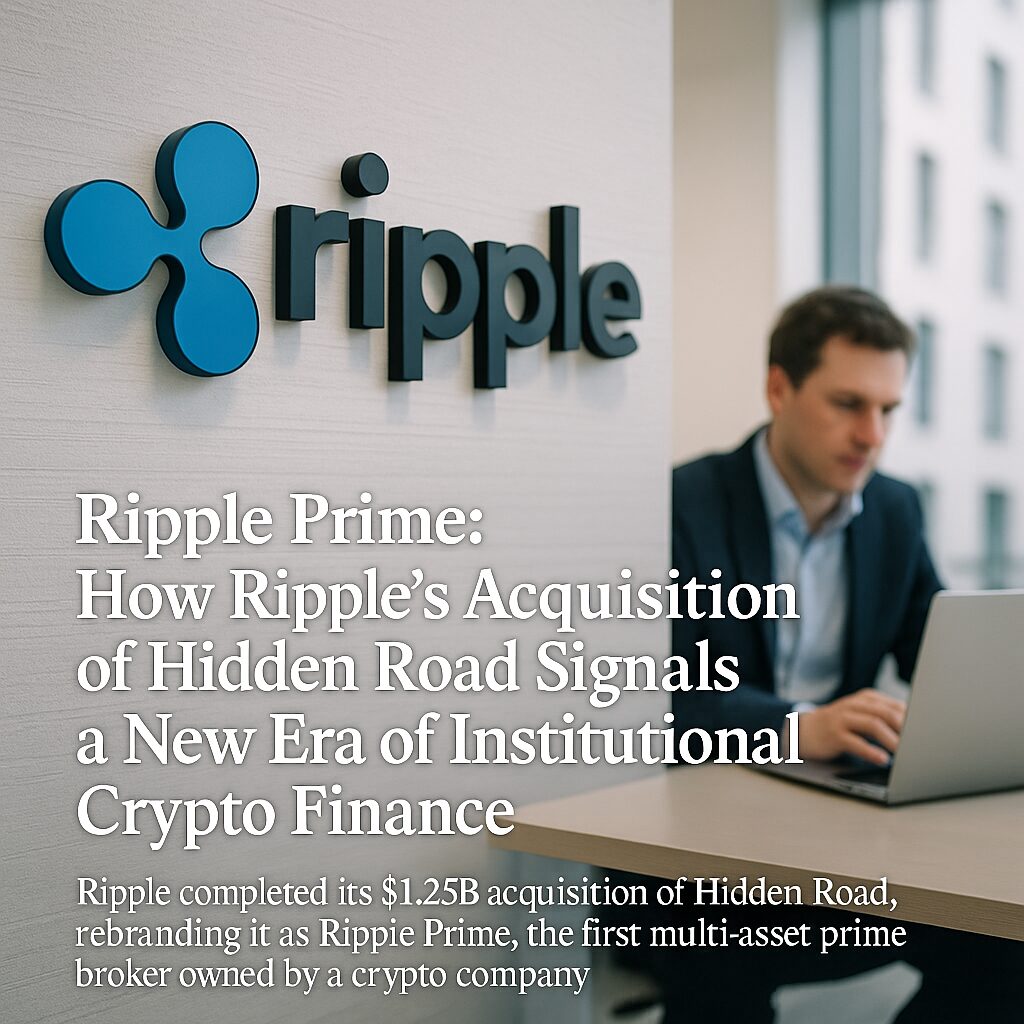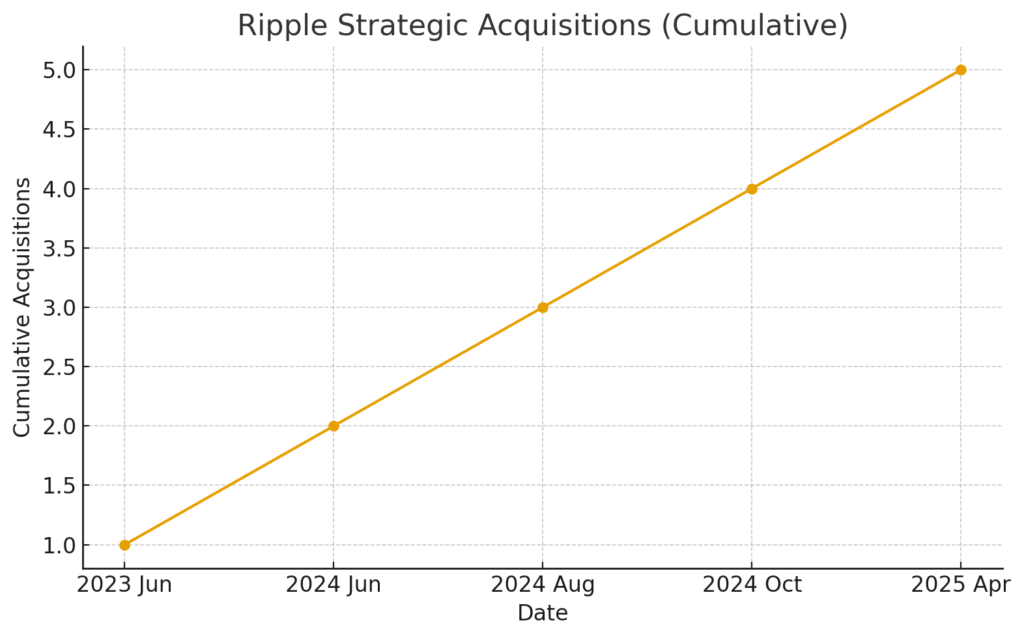
Main Points :
- Ripple completed its $1.25B acquisition of Hidden Road, rebranding it as Ripple Prime, the first multi-asset prime broker owned by a crypto company.
- Ripple Prime now offers settlement, financing, derivatives, swaps, FX, and bond brokerage — expanding Ripple far beyond the traditional “crypto company” category.
- The business has already grown 3× since the deal was announced in April.
- Ripple aims to merge TradFi and blockchain using RLUSD (Ripple USD stablecoin) and XRP as core infrastructure elements.
- Ripple has executed 6 strategic acquisitions in 28 months, reinforcing a long-term institutional strategy.
- This move positions Ripple to become a full-stack financial infrastructure provider for banks, funds, asset managers, and OTC liquidity networks.
I. Ripple’s Most Important Acquisition Yet
Ripple’s acquisition of Hidden Road — a non-bank prime broker known for managing institutional digital-asset flows — marks one of the most significant corporate expansions in the company’s history. The transaction, valued at $1.25B, instantly transformed Ripple from a blockchain infrastructure provider to an institutional financial services conglomerate.
Ripple’s renaming of the company to Ripple Prime is much more than cosmetic. It signals the company’s ambition to offer the same class of services that large Wall Street brokers and global prime-brokerage institutions have traditionally monopolized.
Ripple now becomes the first cryptocurrency firm to fully own and operate a multi-asset prime broker, giving it a structural advantage that even some traditional players do not possess.
II. What Ripple Prime Now Offers
Ripple Prime’s expanded service suite includes:
1. Multi-Asset Settlement
Ripple Prime supports institutional settlement across:
- digital assets
- derivatives
- swaps
- foreign exchange (FX)
- fixed income / bonds
This positions the company as a bridge between markets that were previously siloed.
2. Institutional Financing
Prime financing capabilities — traditionally limited to hedge funds — now become available within a crypto-native infrastructure.
3. Brokerage Across Traditional and Digital Markets
Institutions can now trade both traditional and blockchain-based assets under a unified prime-broker environment.
This is a clear move toward Ripple’s long-stated mission:
“to merge blockchain-based liquidity with legacy financial infrastructure.”
III. Rapid Growth: Ripple Prime Already Tripled in Scale
According to Ripple, the newly rebranded business is already three times larger than when the deal was first announced. This growth stems from:
- demand from existing Ripple institutional users
- new institutional entrants seeking regulated crypto infrastructure
- increased settlement volume for USD-backed assets
- strong derivatives demand, particularly in dollar-denominated products
This early expansion suggests that Ripple Prime will rapidly evolve into a major institutional liquidity venue.
IV. The Strategic Role of RLUSD in Ripple Prime
Ripple’s USD-backed stablecoin RLUSD plays a critical role in the upgraded ecosystem. Ripple confirmed that:
- several derivatives clients already hold balances in USD-denominated stablecoins
- RLUSD is being used as collateral within multiple prime-broker products
- RLUSD will serve as a trusted settlement asset for cross-market flows
This enables Ripple to link:
- XRP as a liquidity token
- RLUSD as a cash-equivalent settlement token
- Ripple Prime as the institutional execution layer
The result is a vertically integrated system designed to rival global financial networks.
V. Blockchain Integration Into Prime Brokerage
Ripple has stated that it will embed blockchain capabilities directly into Ripple Prime’s internal operations.
Expected Enhancements
- reduced settlement friction
- significantly lower operational costs
- automated collateral management
- on-chain transparency for institutions
- instant global settlement for FX and digital assets
Ripple is the only major blockchain company actively integrating blockchain inside a prime-broker infrastructure rather than only offering it as an external service.
This forms the foundation of what could become the first hybrid TradFi + On-Chain liquidity system built at institutional scale.
VI. Ripple’s Accelerating M&A Strategy
Ripple has acquired six companies in 28 months, signaling an aggressive institutional consolidation strategy.
List of Acquisitions
| Date | Acquisition | Category |
|---|---|---|
| 2023 Jun | Metaco | Digital asset custody |
| 2024 Jun | Standard Custody | Regulated crypto custody |
| 2024 Aug | Rails | Stablecoin payment platform |
| 2024 Oct | G-Treasury | Treasury management |
| 2025 Apr | Hidden Road (Ripple Prime) | Multi-asset prime brokerage |
| +1 more | (Undisclosed/Minor acquisition) | — |
These acquisitions collectively build a complete institutional stack:
- custody
- payments
- treasury
- settlement
- prime services
Ripple is clearly shifting from a single-product company (XRP-based settlement) to a diversified global financial-infrastructure provider.
VII. Industry Context: Why This Move Matters Now
Examining recent data from institutional markets:
- Institutional crypto derivatives volumes continue to surpass spot markets.
- Major banks are exploring on-chain settlements for FX and fixed income.
- Stablecoin settlement demand (USDT, USDC) exceeded $12 trillion annually across 2023–2024.
- Hedge funds increasingly require prime brokers who can handle both crypto and TradFi assets simultaneously.
Ripple Prime positions Ripple directly in the middle of all four megatrends.
This explains why the acquisition is considered “one of the most important in Ripple’s history.”
VIII. What This Means for Investors Looking for New Crypto Opportunities
For investors seeking new crypto assets, yield opportunities, and blockchain applications, Ripple Prime’s creation signals several key trends:
1. Institutional Liquidity Will Grow
Better prime brokerage generally means:
- tighter spreads
- deeper liquidity
- more professional market makers
This is bullish for RLUSD, XRP, and related institutional assets.
2. Stablecoin Demand Will Accelerate
If RLUSD becomes widely used as collateral and settlement currency, liquidity demand could expand significantly.
3. Hybrid TradFi + Crypto Networks Are the Future
Ripple is building the infrastructure that BlackRock, Fidelity, and global banks will eventually need:
blockchain settlement with traditional asset support.
IX. Chart: Ripple’s Strategic Acquisitions Over Time

X. Conclusion
Ripple’s acquisition of Hidden Road and the launch of Ripple Prime represent one of the most substantial evolutions in institutional crypto finance. Ripple now controls a multi-asset prime broker capable of serving hedge funds, banks, and institutional allocators across traditional and digital markets.
With RLUSD, XRP, and integrated blockchain infrastructure, Ripple is constructing a vertically unified system that merges the best of TradFi efficiency with the speed of on-chain settlement.
For investors seeking new crypto opportunities, this development confirms a broader trend:
the future of digital assets is institutional, cross-market, and firmly integrated with global finance.

